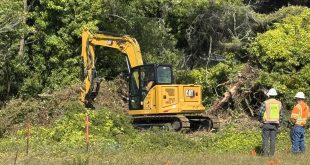by Laura Baker, Board Member
In 2021 FoGR learned of a chemical found in tire grit that pollutes stormwater and kills a number of different aquatic species. It is especially toxic to coho salmon— 40 parts per billion in a quart of stormwater kills juvenile coho. Information has been pouring out of the State of Washington where the effects of 6 PPD were first discovered as scientists race to learn more about how the compound kills and what can be done about it.
The compound is intentionally added to tires as a safety measure to reduce wear when the rubber is exposed to ozone. The bad news is that this compound is found in tires, playground rubber mats, and anywhere that tires are recycled and re-used. While there are lawsuits aimed against tire manufacturers to find a substitute for 6 PPD (which becomes the more hazardous 6 PPD-Q when exposed to ozone), the short-term answer contains some good news: early research suggests that stormwater that is captured and allowed to percolate through different media like soil, compost, etc., can be cleaned of 6 PPD-Q.
Thanks to the collaboration between FoGR and The Stream Team (with whom we work to monitor water in the estuary), we began to investigate the fate of stormwater that flows untreated from downtown Gualala into our estuary/lagoon.

Virtually every drop of stormwater that originates above the estuary from the mobile home park down to the highway bridge across the river is conveyed through the stormwater system directly into the estuary. But does it contain 6 PPD/6 PPD-Q? Some people have expressed doubt that there’s enough vehicle traffic in Gualala to generate measurable amounts of 6 PPD-Q and other toxins.
The answer to this important question lies in data that we have collected from 3 separate storm events (May 4th, October 12th, and November 1st, 2024). In every sample collected in accordance with the strict protocols established by the US Environmental Protection Agency, we detected 6 PPD-Q in significant amounts. In all but one sample, the amounts exceeded the LC 50 for juvenile coho. The LC 50 is the lethal concentration of a toxin that kills 50% of the population which, for juvenile coho, is 40 nanograms/liter with less than 24 hours of exposure. It’s hard to wrap one’s head around just how small an amount that figure represents, so here’s a simple example. One quarter of a teaspoon of sugar = 1 gram. Divide that by 1 billion to get 1 nanogram: in other words 40 billionths of a gram per liter which is about a quart.
The laboratory tests for 6 PPD-Q are expensive. Fortunately, The Stream Team landed a small grant from the Rose Foundation to help pay for some of the initial costs associated with analyzing 6 PPD-Q and for updating their Monitoring Plan (MP) and Quality Assurance Project Plan (QAPP) to ensure the data we collect is technically valid and informs management and restoration plans currently being developed for the Gualala River and estuary.
Is there a way to intercept and treat the stormwater pouring into our estuary? The Gualala Streetscape Project offers an opportunity to look critically at how the current stormwater system might be modified to accomplish that. To that end, FoGR has hired Greg Kamman, an ecohydrologist with cbec engineering, and continues to partner with The Stream Team to devise a potential plan to address that issue. We will be releasing more information as it develops.
 Friends of Gualala River Protecting the Gualala River watershed and the species living within it
Friends of Gualala River Protecting the Gualala River watershed and the species living within it


